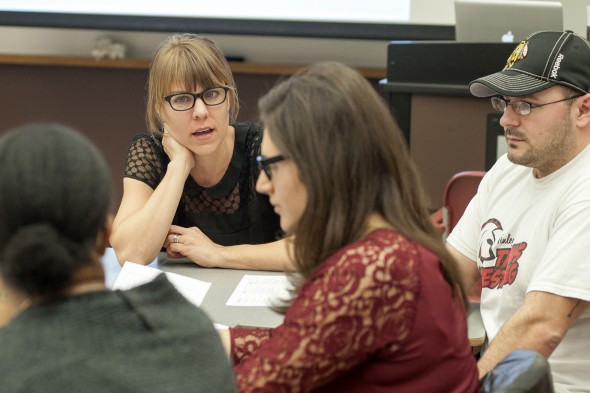Teaching the value of relationships

Jennifer Olson gives her students advice on becoming teachers. “Know your students and build a curriculum that meets their needs,” she says. Photo: Roberta Dupuis-Devlin/UIC Photo Services
Since 1966, the Silver Circle Award has been presented to some of UIC’s best teachers. Winners, who are honored at their college commencements, receive $500 and their names join a long list of distinguished colleagues. But what makes the award especially meaningful is its selection committee: the graduating seniors.
Jennifer Olson taught for 10 years at Chicago’s Harper High School, which underwent two turnarounds in 11 years, before she started her doctoral studies in education at UIC.
Olson did her dissertation on how students in two other urban high schools were affected by turnarounds — a process where the Chicago Board of Education replaces a school’s administration, teachers and staff.
Those experiences showed Olson the value of relationships between educators and students, so she appreciates receiving a Silver Circle after only two years of teaching at the college level.
“It’s so meaningful for me to have an award given by my students,” says Olson, visiting clinical assistant professor. “Teaching is absolutely what’s most important to me.
“I struggled with leaving my job as a high school teacher. I loved it so much. Now that I’ve been here two years, I know I can teach my students to make connections with their own students, and that way I can make an impact on more students.”
Olson especially enjoys teaching the course in curriculum, instruction and assessment that immediately precedes student teaching. By then, her students have studied theory; they need practical tools and strategies.
“I’m able to make connections between theory and practice, because I pull from my experience as a high school teacher. If we talk about classroom management, I give them examples and tell them what worked for me.”
Before their student teaching, Olson’s students do a 60-hour practicum in Chicago high schools. She gives them feedback after watching a lesson.
“That’s exciting, because for many of them, it’s the first time they’ve been in front of real teenagers. Those conversations afterward are really fun,” she says.
Olson’s advice on how to teach?
“Know your students and build a curriculum that meets their needs,” she says. “Craft your instruction and assessment the same way. Keep asking questions.”
